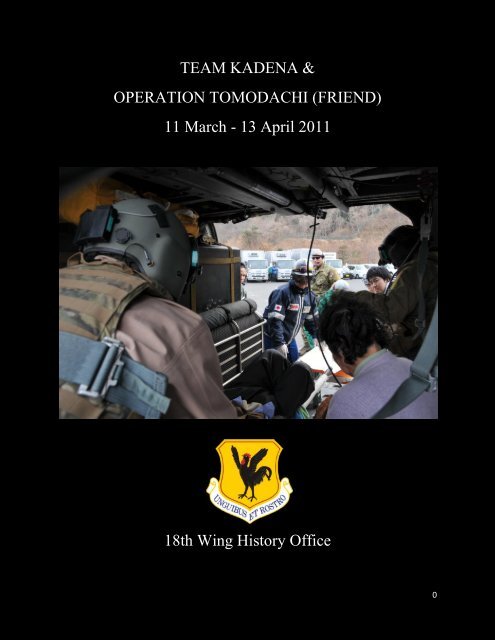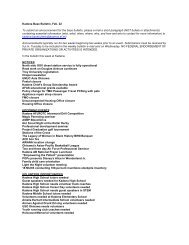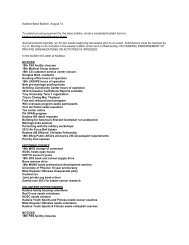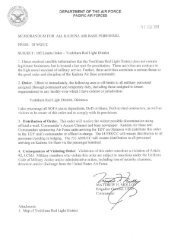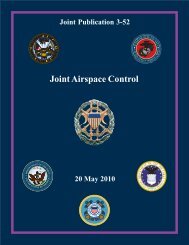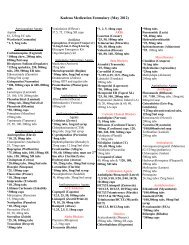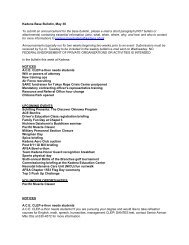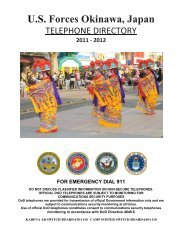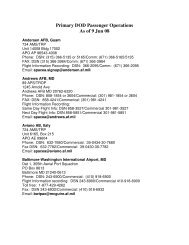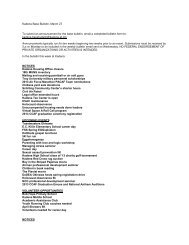TEAM KADENA & OPERATION TOMODACHI ... - Kadena Air Base
TEAM KADENA & OPERATION TOMODACHI ... - Kadena Air Base
TEAM KADENA & OPERATION TOMODACHI ... - Kadena Air Base
You also want an ePaper? Increase the reach of your titles
YUMPU automatically turns print PDFs into web optimized ePapers that Google loves.
<strong>TEAM</strong> <strong>KADENA</strong> &<br />
<strong>OPERATION</strong> <strong>TOMODACHI</strong> (FRIEND)<br />
11 March - 13 April 2011<br />
18th Wing History Office<br />
0
TABLE OF CONTENTS<br />
INTRODUCTION 03<br />
RESCUE-RECOVERY-RESUPPLY <strong>OPERATION</strong>S 04<br />
POWERING MISAWA AIR BASE 07<br />
HUMANITARIAN AID (733 AMS / 18 LRS) 08<br />
YOUNG TIGERS (909 ARS) 09<br />
<strong>KADENA</strong> P-3 ORION <strong>OPERATION</strong>S (USN) 10<br />
353RD SPECIAL <strong>OPERATION</strong>S GROUP IN ACTION 11<br />
LANDING AT MATSUSHIMA AB 13<br />
SYMBOL OF HOPE (RE-OPENING SENDAI IAP) 14<br />
RETURNING HOME 18<br />
<strong>TEAM</strong> <strong>KADENA</strong> TIMELINE 20<br />
CASUALTY MAP 24<br />
APPENDICIES 25<br />
BIBLIOGRAPGHY 29<br />
1
After an epic 9.0 earthquake rocked mainland Japan, you sprang into action to deploy into the<br />
area with humanitarian capabilities and donations. The 353 Special Operations Group, and the<br />
31st and 33rd Rescue Squadrons were able to help open up Sendai <strong>Air</strong>port, giving a critical<br />
supply hub for relief operations. 1<br />
Brigadier General Kenneth Wilsbach<br />
Commander, 18th Wing<br />
Although there was a tremendous amount of destruction on the island of Honshu, I will tell you<br />
that each United States service member that was present was encouraged by the strength and<br />
resiliency of the Japanese people. And the people of Japan throughout gave all of us hope for<br />
Japan’s future. I believe they have a very bright future as they recover from this disaster. And<br />
from our homes on Okinawa, we continue to lend our support. Although we repositioned back on<br />
Okinawa, we remain ready in response to requests for assistance from the Government of Japan<br />
if they should come in the future. 2<br />
Colonel Robert P. Toth<br />
Commander, 353rd Special Operations Group<br />
An MC-130P from the 17th SOS lands<br />
at Yokota <strong>Air</strong> <strong>Base</strong>, 13 March 2011.<br />
1 Article (U), Brig Gen Kenneth Wilsbach, 18 WG/PCC, “Sayonara to Team <strong>Kadena</strong>,” AF News Print, 26 May<br />
2011.<br />
2 Article (U), Col Robert Toth, 353 SOG/CC, “Operation Pathfinder,” <strong>Air</strong> Commando Journal, Fall 2011.<br />
2
INTRODUCTION<br />
On 11 March 2011 a magnitude 9.0 earthquake struck near the east coast of Honshu, Japan<br />
at 1446 local time. The earthquake lasted over six minutes in duration and was Japan’s largest<br />
earthquake in recorded history.<br />
Following the earthquake a<br />
massive tsunami with waves<br />
reaching 33 feet at its highest<br />
point swept across the Tohoku<br />
region decimating entire towns.<br />
The tsunami created a nuclear<br />
emergency when waves struck<br />
the Tokyo Electric Power<br />
Companies’ (TEPCO)<br />
Fukushima Daiichi Nuclear Power Station, disabling the plant’s cooling system. As of<br />
September 2011, the earthquake and ensuing tsunami killed at least 15,703, and injuring another<br />
5,314 people. The Japanese government reported 4,647 people are still unaccounted for and<br />
another 130,927 displaced. Thousands of buildings were damaged or destroyed in the wake of<br />
the tsunami. According to the United States Geological Survey (USGS) the Tohoku<br />
Earthquake/Tsunami was estimated to cost the Japanese Government over 309 billion dollars<br />
worth of damage. 3<br />
Immediately following the earthquake, the Government of Japan (GOJ) established an<br />
emergency headquarters commanded by Prime Minister Naoto Kan. The rescue and relief effort<br />
was lead by the Government of Japan. All coordination between foreign government rescue<br />
teams, humanitarian aid, relief supplies, and foreign media was handled by the Ministry of<br />
Foreign Affairs (MOFA). The GOJ requested assistance from the US Government through the<br />
3 Report (U), Mr. Toshimi Kitazawa, Minister of Defense, “On the Publication Of Defense of Japan 2011,” Japanese<br />
Ministry of Defense, ca. 2011; Report (U) USGS, “Earthquake Summary, Magnitude 9.0 Near the East Coast of<br />
Honshu Japan,” ca 2011. Article (U), A1C Katrina R. Menchaca, 374 AW/PA, “Japanese Ministry of Foreign<br />
Affairs gives thanks for Operation Tomodachi,” 7 May 2011.<br />
3
US embassy. United States <strong>Air</strong> Force assets that assisted the GOJ were lead by Lieutenant<br />
General M. Field, commander of United States Forces Japan (USFJ) and Fifth <strong>Air</strong> Force. 4<br />
<strong>Kadena</strong> <strong>Air</strong> <strong>Base</strong>’s strategic location on Okinawa, Japan aided the GOJ’s efforts to stabilize the<br />
situation that devastated the Tohoku region. The following report highlights the contributions<br />
from multiple US <strong>Air</strong> Force and Navy units stationed on <strong>Kadena</strong> <strong>Air</strong> <strong>Base</strong>, in what would<br />
become known as Operation <strong>TOMODACHI</strong> (Friend). As the host unit on <strong>Kadena</strong> <strong>Air</strong> <strong>Base</strong>, the<br />
18th Wing worked with our team <strong>Kadena</strong> partners the 353rd Special Operations Group<br />
(AFSOC) and the Navy’s Commander Fleet Activities Okinawa. Assigned to US Pacific <strong>Air</strong><br />
Forces’ 5th <strong>Air</strong> Force, during Operation <strong>TOMODACHI</strong> 18 WG operated in support of the<br />
Japanese Government from restoring power at Misawa <strong>Air</strong> <strong>Base</strong> to opening up Sendai<br />
International <strong>Air</strong>port. 5<br />
RESCUE-RECOVERY-RESUPPLY <strong>OPERATION</strong>S<br />
One day after the earthquake/tsunami, members from both rescues squadrons stationed on<br />
<strong>Kadena</strong> deployed to Yokota <strong>Air</strong> <strong>Base</strong>, Japan. The 33rd Rescue Squadron deployed 25 personnel<br />
and five Sikorsky HH-60G Pave Hawk Helicopters. Flying out with the 33rd were members of<br />
A 33rd Rescue Squadron HH-60G Pave Hawk Helicopter departs for<br />
Yokota, March 2011.<br />
the 31st Rescue Squadron.<br />
The 31st Rescue squadron<br />
deployed<br />
eleven<br />
pararescuemen, two Combat<br />
Rescue Officers and one<br />
Search, Evasion, Resistance,<br />
and Escape Specialist as<br />
well as a communications<br />
specialist. The 33 RQS “Jolly Green” crews began rescue and recovery operations on the 13th of<br />
March from Yokota AB. The initial missions took the crews over the city of Tokyo and as far<br />
north as Sendai. On board were members of the 31st Rescue Squadron and 320th Special<br />
4 Briefing (U), Lt Col Devin Smith, 18 WG/DS, “Team <strong>Kadena</strong> Operation Tomodachi,” 12 Sep 2011.<br />
5 Report (U) , Maj Theresa Murphy, 18 OG/DS, “18th Operations Group Monthly Activity Report,” Mar 2011.<br />
4
Tactics Squadron of the 353rd Special Operations Group collocated with the 18 WG on <strong>Kadena</strong><br />
AB.<br />
Within the first ten days of the operation, the 33rd Rescue flew 142 flight hours. Most<br />
sorties consisted of daily disaster relief missions, air crews from the 33rd Rescue Squadron<br />
assisted by bringing food, water, and medical supplies to displaced Japanese citizens. Although<br />
the Rescue Squadrons did record a save during the operation, the missions quickly changed from<br />
search and rescue to reconnaissance of the devastated areas. 6<br />
<strong>Kadena</strong> rescue squadrons were<br />
tasked by Combined Joint Task Force (CJTF) to support the US Dept of Energy (DOE).<br />
Missions included the insertion of DOE technicians<br />
sampling missions over and around Fukashima.<br />
into towns and conducting airborne<br />
The 33 RQS later flew members of both US<br />
and Foreign Aid agencies into the hardest hit areas allowing for a more accurate picture of the<br />
situation, allowing the agencies to focus their relief efforts. The combined missions gave the<br />
GOJ a more accurate model of the devastated areas, and helped top decision makers with<br />
evacuations and follow on aid. 7<br />
From the 13 through the 15th of<br />
March, members of the 31 RQS, 33 RQS,<br />
and 320 STS conducted missions<br />
specifically designed with the intent to<br />
survey airfields and locate possible<br />
forward area refueling points (FARP).<br />
<strong>Air</strong>fields within the hardest hit areas<br />
became of utmost importance in order to<br />
create an airhead for oncoming<br />
humanitarian aid and relief supplies.<br />
Lt Col Stephen Goodman, squadron commander of the<br />
31st Rescue Squadron (18 WG), and Major John Traxler, commander of the 320 STS, were both<br />
onboard. Both were well versed in disaster relief missions.<br />
The surveys were looked over by<br />
Colonel Robert P. Toth Commander of the 353 SOG. Col Toth determined that Sendai <strong>Air</strong>port<br />
had the highest potential to allow for follow on humanitarian aid and relief supplies. At the time<br />
of the survey much of the airport was still underwater. 8<br />
Major Traxler (left) and Lt Col Goodman<br />
(center-sitting) survey the area from an 18th<br />
Wing Pave Hawk helicopter.<br />
6 Article (U), Col Robert Toth, 353 SOG/CC, “Operation Pathfinder,” <strong>Air</strong> Commando Journal, Fall 2011.<br />
7 Email (U), Maj Mathew Mcguinness, 31 RQS/DO, “Tomodachi Report,” March 2012.<br />
8 Article (U), Col Robert Toth, 353 SOG/CC, “Operation Pathfinder,” <strong>Air</strong> Commando Journal, Fall 2011.<br />
5
On 14 March a HH-60G Pave Hawk from the<br />
33rd Rescue Squadron was conducting a nighttime<br />
search and rescue mission over Sanriku-Cho, Miyagi<br />
Prefecture, when the crew noticed the letters “S-O-S”<br />
200 people spelled out on-top of a roof of a senior<br />
care facility. Onboard the Pave Hawk helicopter was<br />
23 year-old Senior <strong>Air</strong>men Veronica Cox, an Intel<br />
specialist assigned to the 33 RQS. SrA Cox spoke fluent Japanese volunteered to fly with the 33<br />
RQS as an interpreter incase her language skills were needed. That night, crew members hoisted<br />
Cox down to the roof top of the senior center to do just that. The SrA spoke to the staff in<br />
Japanese “We are U.S. <strong>Air</strong> Force personnel. We’re here to help.”9 The 200 people who sought<br />
A crew from the 33rd Rescue Squadron assisted by bringing<br />
food, water, and medical supplies to displaced Japanese<br />
citizens.<br />
desperately low when the crew arrived.” 10<br />
SrA Veronica Cox<br />
refuge in the building were<br />
residents of the town, staff<br />
members, and seniors.<br />
The<br />
crew delivered food water and<br />
blankets, the people taking<br />
shelter in the building were<br />
relieved that SrA Cox spoke<br />
Japanese so they could<br />
communicate their current<br />
situation. The supplies within<br />
the building were running<br />
9 Report (U), 18 WG/PA, “Japan-America <strong>Air</strong> Force Goodwill Association recognizes Naha and <strong>Kadena</strong> top<br />
<strong>Air</strong>men,” AF News Print, 2 Feb 2012; Email (U), Mr. Ed Gulick, 18 WG/PA to Mr. James D’Angina, 18 WG/HO,<br />
16 Feb 2012.<br />
10 Ibid.<br />
6
POWERING MISAWA AIR BASE<br />
The destructive power of the 9.0 earthquake disrupted commercial power and utilities to<br />
Misawa <strong>Air</strong> <strong>Base</strong> in Sapporo.<br />
Engineers from the 18th CEG arrive at Misawa AB to help restore<br />
power to the base, 12 March 2011.<br />
Misawa’s 35th Civil Engineer Squadron issued a request for<br />
assistance and <strong>Kadena</strong> <strong>Air</strong>men<br />
responded. With their sister base<br />
in crucial need of support<br />
engineers from the 18th Civil<br />
Engineer Group set out for Misawa<br />
to get the base back on line. One of<br />
the first aircraft airborne from<br />
<strong>Kadena</strong> to assist with disaster relief<br />
was a Boeing KC-135R<br />
Stratotanker from the 909th <strong>Air</strong><br />
Refueling Squadron tasked to transport the engineers. The 909 ARS crew took off at 2210 local<br />
with only five hours notice preceding their flight. Just 32 hours after the earthquake struck, 53<br />
engineers (later 58 in total) from the 18th<br />
Civil Engineer Group and their equipment<br />
were at Misawa getting the base back online. 11<br />
The frigid temperatures at Misawa made it<br />
imperative that certain operations had<br />
continuous power.<br />
A number of engineers<br />
from the 18th Wing received <strong>Air</strong> Force<br />
Achievement awards from the 35th Mission<br />
Support Group for their assistance. The<br />
engineers performed high voltage switching operations protecting Misawa’s 100 million dollar<br />
power grid, made emergency heating system repairs for six U.S. Navy helicopter hangars, and<br />
restored water and utilities to over 1,200 facilities on base utilized by both USFJ and Japanese<br />
Self Defense Force during Operation <strong>TOMODACHI</strong>. 12<br />
11 Article (U), 18 WG/PA, “Okinawa <strong>Air</strong>men deploy to Support Relief Mission,” AF Print News, 12 Mar 2011.<br />
12 Award (U), 18 CEG, Tomodachi Support Awards. Report (U) 909 ARS/DO, “Tracker,” 25 Mar 2011.<br />
7
HUMANITARIAN AID (733 AMS / 18LRS)<br />
the 733rd<br />
<strong>Air</strong>men from both<br />
<strong>Air</strong> Mobility<br />
Squadron (733 AMS) and<br />
18th Logistics Readiness<br />
Squadron made significant<br />
contributions to the relief<br />
effort during Operation<br />
<strong>TOMODACHI</strong>. The 733<br />
AMS falls under the <strong>Air</strong><br />
Mobility Command at Scott<br />
<strong>Air</strong> Force <strong>Base</strong>, Illinois. The 18th Logistics Readiness Squadron (18 LRS) was assigned to the<br />
18th Wing; both units are collocated on <strong>Kadena</strong> <strong>Air</strong> <strong>Base</strong>. <strong>Air</strong>men from the 733 AMS and 18th<br />
LRS prepared 972 short tons of humanitarian aid and disaster relief (HADR) from <strong>Kadena</strong>. The<br />
equipment ranged in size and priorities, the squadron’s services became the supply line for<br />
Members from the 733rd AMS<br />
load a JGSDF truck onto an<br />
Australian C-17 Globemaster III.<br />
multiple branches of the<br />
US Military and the<br />
Japanese Self Defense<br />
Forces.<br />
<strong>Kadena</strong> <strong>Air</strong>men<br />
moved a total of 423<br />
passengers during the<br />
operation,<br />
including<br />
soldiers from the Japanese<br />
Ground Self Defense Force<br />
15th Brigade. 13<br />
13 Report (U), 733 AMS/DO, “733rd AMS Tomodachi Support,” ca. 2011.<br />
8
909 AIR REFUELING SQUADRON (YOUNG TIGERS)<br />
At 2210 Local a single<br />
KC-135R Stratotanker<br />
from the 909th <strong>Air</strong><br />
Refueling<br />
Squadron<br />
launched from <strong>Kadena</strong><br />
<strong>Air</strong> <strong>Base</strong>. USFJ tasked<br />
the crew to deploy a<br />
team of engineers to<br />
restore power at<br />
Misawa <strong>Air</strong> <strong>Base</strong>.<br />
The mission was the<br />
first US aircraft to<br />
deliver personnel and supplies in support of Operation <strong>TOMODACHI</strong>.<br />
The squadron had<br />
multiple aircrews on alert status from 13-16 March. On 16 thru 17 March, crews from the 909<br />
ARS launched in support of an 18 AES aero medical evacuation squadron mission. The mission<br />
profile called for the crew to deliver a patient from Atsugi Naval <strong>Air</strong> Station to higher medical<br />
care at Hickam <strong>Air</strong> Force <strong>Base</strong>, Hawaii. While stopped at Hickam, the crew loaded iodine<br />
tablets (used to prevent radiation poisoning) scheduled to be delivered to Yokota AB. The<br />
Young Tigers delivered the iodine tablets to their sister base on their return leg to <strong>Kadena</strong> AB.<br />
On a return flight from Hickam, a Stratotanker crew dropped off 17 US Navy nuclear biological<br />
test personnel at Yokota, the teams set up tests to measure radiation levels on arriving and<br />
departing aircraft operating from Yokota. The 909 ARS executed their first evacuee flight on 22<br />
March; the evacuees consisted of nine expecting mothers and 16 dependents from Atsugi to<br />
<strong>Kadena</strong>.<br />
A second leg was added to the mission in which a crew evacuated 30 additional<br />
expecting mothers and dependents to safety. 14 In total, aircrews from the 909 ARS launched<br />
from <strong>Kadena</strong> a dozen times, moving over 132 passengers.<br />
Members from the 18 Aeromedical<br />
Evacuation Squadron<br />
board a KC-135R.<br />
14 Report (U), Maj Theresa Murphy, 18 OG/DS, “18th Operations Group Monthly Activity Report,” Mar 2011;<br />
Report (U), Maj Theresa Murphy, 18 OG/DS, “18th Operations Group Monthly Activity Report,” Apr 2011; Report<br />
(U), 909 ARS/DO, “Operation <strong>TOMODACHI</strong>,” 30 Mar 2011.<br />
9
<strong>KADENA</strong> P-3 ORION <strong>OPERATION</strong>S (UNITED STATES NAVY)<br />
On 12 March United States Navy<br />
P-3C Orion crews began flying<br />
sorties from <strong>Kadena</strong> <strong>Air</strong> <strong>Base</strong> in<br />
support of Operation<br />
<strong>TOMODACHI</strong>. A Lockheed P-3C<br />
Orion crew from Patrol Squadron<br />
Four (VP-4) were the first US<br />
aircraft on station to make initial<br />
damage assessments along the Japanese coastline a day after the earthquake. The squadron<br />
conducted aerial reconnaissance and search and rescue sorties along the Honshu coast. The<br />
squadron mapped numerous debris fields (at sea and on land) and conducted damage surveys of<br />
Japanese lines of communication. The mapping performed by the crews enabled both the<br />
Imaging equipment aboard a P-3 Orion displays<br />
damaged areas of Northern Japan.<br />
A Lockheed P-3C Orion crew from VP-4 prepares for another<br />
mission from Misawa AB.<br />
Japanese and US operations to resupply<br />
isolated Japanese personnel. The P-3 crews<br />
carried out both port and airfield survey<br />
missions in order to locate suitable<br />
embarkation sites. The aircrews streamed<br />
video feeds from their aircraft to the USS<br />
Essex, an amphibious assault ship located<br />
offshore, for future landing craft operations.<br />
The ships used the feeds to aid them in resupplying<br />
islands in northern Honshu that<br />
were not accessible by land. From <strong>Kadena</strong> <strong>Air</strong> <strong>Base</strong> alone, the crews flew a total of 130 hours<br />
over 18 missions. The squadron deployed a detachment from <strong>Kadena</strong> consisting of two P-3C<br />
Orion aircraft, four P-3 aircrews, and 81 personnel to Misawa AB. From 17 through 30 March,<br />
This detachment flew missions continuously out of Misawa. From Misawa, the two aircraft<br />
10
executed 18 sorties and 124.6 hours in support of Operation <strong>TOMODACHI</strong>.<br />
redeployed back to <strong>Kadena</strong> <strong>Air</strong> <strong>Base</strong> after conducting 18 sorties and logging 124.6 hours. 15<br />
The DET<br />
353RD SPECIAL <strong>OPERATION</strong>S GROUP IN ACTION<br />
On 13 March, the main body of the 353rd Special Operations Group (353 SOG) arrived<br />
at Yokota <strong>Air</strong> base from Daegu<br />
AB, Republic of Korea. When the<br />
earthquake struck the Tohoku<br />
Region, the group was<br />
participating in Exercise FOAL<br />
EAGLE. In less than 24 hours,<br />
Col Toth had repositioned 180<br />
personnel and three MC-130P<br />
Combat Shadow aircraft from the<br />
17th Special Operations Squadron<br />
to Yokota. Col. Toth the Joint<br />
Force Special Operations Component Commander (JFSOCC) had under his control all special<br />
operation forces in theater. These units included the 353 SOG, the US Army’s First Battalion,<br />
First Special Forces Group (<strong>Air</strong>borne) [1-1 SFG (A)] and the Naval Special Warfare Unit-1<br />
(NSWU-1) out of Guam. 16 Their mission was as follows:<br />
“Mission: 353 Special Operations Group elements advance to Matsushima<br />
<strong>Air</strong> Field (JASDF) and Sendai <strong>Air</strong>port in order to establish USFJ hub for<br />
HA/DR operations, restore operational capability and return control to the<br />
Government of Japan. Concurrently, transport humanitarian assistance and<br />
disaster relief supplies to affected population in order to alleviate human<br />
suffering. On order, 1-1 SFG (A) and (NSWU-1) conduct point assessments<br />
15 Report (U), Commander Fleet Activities Okinawa, “USN Okinawa Tomodachi Summary,” 6 April 2011.<br />
16 Briefing (U), Col Robert Toth, 353 SOG/CC, to ADM Eric Olson, PACOM/CC, “Joint Force Special Operations<br />
Component (JFSOC): By, With and Through Approach to HADR,” 23 Apr 2011; Article (U), Col Robert Toth, 353<br />
SOG/CC, “Operation Pathfinder,” <strong>Air</strong> Commando Journal, Fall 2011.<br />
11
in Miyagi and Iwate provinces to identify response capability gaps or identify<br />
persons of need.” (Col. Robert P. Toth) 17<br />
One day after the main body of the 353 SOG forces were on the ground at Yokota,<br />
Colonel Toth received approval from Lt Gen Field, commander United States Forces Japan, to<br />
proceed with a rotary wing option into Sendai International <strong>Air</strong>port. Due to the lack of 353 SOG<br />
rotary wing assets, the Special Operations Group required assistance from the 18th Wing’s 33rd<br />
Rescue Squadron in order to complete the mission. The 33 RQS made two attempts to get into<br />
An HH-60G Pave Hawk from the 33RQS takes on fuel from a<br />
17 SOS MC-130P Shadow during Operation <strong>TOMODACHI</strong>.<br />
Sendai on the 15 th of March 2011.<br />
Higher headquarters scrubbed the<br />
first attempt due to concerns over<br />
radiation levels within the area; the<br />
teams did not have dosimeters on<br />
them and were ordered to turn<br />
around as a safety precaution. The<br />
crew aborted the second attempt<br />
after weather conditions made it<br />
impossible to get into Sendai. Both<br />
HH-60G Pave Hawk crews with their insertion teams from the 320 th Special Tactics Squadron<br />
returned to base. Operators expected the bad weather to remain in the area between Yokota AB<br />
and Sendai. The poor weather took the rotary wing option off the table. Colonel Toth had one<br />
other option his <strong>Air</strong>men specialized in; a fixed-wing insertion. Lt Col Eric Zimmerman,<br />
commander of the 17th Special Operation Squadron, and Major Traxler, commander of the 320<br />
Special Tactics Squadron devised a plan for a fixed wing option to open up Sendai IAP. Both<br />
commanders ruled out landing at Sendai due to the lack of 3,500 feet of runway.<br />
commanders turned their attention to the Japanese <strong>Air</strong> Self Defense (JASDF) airfield at<br />
Matsushima, a 90-minute drive from Sendai. Matsushima became the key to re-opening up<br />
Sendai International <strong>Air</strong>port. 18<br />
The<br />
17 Article (U), Col Robert Toth, 353 SOG/CC, “Operation Pathfinder,” <strong>Air</strong> Commando Journal, Fall 2011.<br />
18 Ibid.<br />
12
LANDING AT MATSUSHIMA<br />
At 0445L on March 16, JAKAL 17, an MC-130P Combat Shadow from the 17th Special<br />
Operations Squadron, departed Yokota <strong>Air</strong> <strong>Base</strong> for Matsushima <strong>Air</strong>field (JASDF). On board<br />
were teams from the 320th Special Tactics Squadron. The unit’s infiltration package included 21<br />
personnel and two HMMWV. This package allowed the 320 STS personnel to convoy to Sendai<br />
after landing at Matsushima. Weather made getting into the damaged Japanese air base difficult.<br />
<strong>Air</strong>craft commander Captain Christopher Stewart had the Combat Shadow over Matsushima in<br />
45 minutes. The scheduled time of arrival at sunrise was predetermined in order to give the<br />
aircrew a good look at the runway. After making an initial pass, the 17 SOS crew determined the<br />
runway had been cleared of debris to their minimum landing distance of 3,500 feet. The crew<br />
Members from the 320th STS arrive at Matsushima AB. A 17th SOS MC-130P<br />
can be seen in the background, 16 March 2011. 2011.<br />
took one more look<br />
before executing a<br />
self-contained<br />
approach in-bound for<br />
Runway 33.<br />
Combat<br />
The<br />
Shadow<br />
landed at 0550L<br />
without mishap. The<br />
aircrew wasted no<br />
time offloading the<br />
infill team and<br />
departed Matsushima<br />
AB. The MC-130P, on a return flight to Matsushima, offloaded the first humanitarian aid /<br />
disaster relief supplies. Controllers from the 320 STS completed a survey of the airfield and<br />
established <strong>Air</strong> Traffic Control services at the disabled airport. Captain Stewart’s crew then<br />
returned to Matsushima for the second time. Lead by Captain Garrett Ianacone, the 320 STS<br />
team at Matsushima continued to provide air traffic control services. They gave access to<br />
multiple relief flights to the field. Within 24 hours, the controllers reestablished normal tower<br />
13
operations. 19 Members of the 320 STS then transitioned air traffic control services the Japanese<br />
authorities, allowing the 320 STS teams to concentrate their efforts on Sendai. 20<br />
A loadmaster from the 17th SOS<br />
takes in the view of the tarmac at<br />
Matsushima AB. Damaged F-2<br />
aircraft from the JASDF can be<br />
seen in the background.<br />
SYMBOL OF HOPE (RE-OPENING SENDAI IAP)<br />
Once on the ground at Matsushima, the 320 STS commander, Major John Traxler, and<br />
JFSOCC Ground Force Commander, Colonel Dwayne Lott, met with Japanese <strong>Air</strong> Self Defense<br />
Force personnel. Once integrated, the team led their convoy to Sendai International <strong>Air</strong>port. Col<br />
Robert Toth explained: “We arrived there at Sendai roughly at 8:00 a.m. in the morning, and by<br />
10:00 a.m., we had 5,000 feet of runway cleared, primarily being worked by Japanese workers<br />
that were there at the field and our <strong>Air</strong> Force Combat Controllers.” Japanese cleanup crews<br />
cleared 5,000 feet of runway and controllers activated commutations and air traffic control<br />
hardware. Members of the 320 STS then declared Sendai IAP ready to accept normal Lockheed<br />
19 Briefing (U), Col Robert Toth, 353 SOG/CC, to ADM Eric Olson, PACOM, “Joint Force Special Operations<br />
Component (JFSOC): By, With and Through Approach to HADR,” 23 Apr 2011; Article (U), Col Robert Toth, 353<br />
SOG/CC, “Operation Pathfinder,” <strong>Air</strong> Commando Journal, Fall 2011.<br />
20 Ibid.<br />
14
C-130 operations. Colonel Lott coordinated with the Japanese Civil Aviation Bureau and the<br />
Sendai <strong>Air</strong>port Authority to create a priority list to aid the relief operation. After four hours, the<br />
team completed the list of necessary aid and equipment, while counterparts sourced them at<br />
Yokota AB. 21<br />
The crew of GOOSE 56 had just landed their aircraft at Yokota AB via Daegu, Republic<br />
of Korea. The MC-130H Combat Talon II from the 1st Special Operations Squadron loaded a<br />
10K forklift needed to download aircraft at Sendai. Colonel Toth joined the Combat Talon II<br />
crew on their way to Sendai. The <strong>Air</strong>craft commander, Major Brian Helton, took off from<br />
Yokota at 1345L. At 1430L, the crew landed at Sendai <strong>Air</strong>port. GOOSE 56 became the first<br />
fixed wing aircraft to land<br />
at Sendai International<br />
<strong>Air</strong>port since the tsunami<br />
just five days prior. 22<br />
The<br />
353 SOG commander,<br />
Colonel Toth, deplaned<br />
while the MC-130H crew<br />
offloaded the forklift and<br />
initial relief supplies. The<br />
aircraft departed for Daegu<br />
GOOSE 56 lands at Sendai International <strong>Air</strong>port. The aircraft is the first<br />
fixed Wing aircraft to land at Sendai since the Tsunami.<br />
21 Briefing (U), Col Robert Toth, 353 SOG/CC, to ADM Eric Olson, PACOM, “Joint Force Special Operations<br />
Component (JFSOC): By, With and Through Approach to HADR,” 23 Apr 2011; Article (U), Col Robert Toth, 353<br />
SOG/CC, “Operation Pathfinder,” <strong>Air</strong> Commando Journal, Fall 2011.<br />
22 Ibid.<br />
15
AB to return to their FOAL EAGLE commitment. That day, three more 353 SOG flights made it<br />
into Sendai offloading items annotated on the Sendai priority list: medical supplies, diesel<br />
generators, fuel, water, and blankets. 23<br />
C-130 operations were only the beginning. Members of the 353 SOG and the Japanese<br />
Civil Aviation Bureau and <strong>Air</strong>port Authority needed to clear the entire runway in order to<br />
accommodate Boeing C-17 Globemaster IIIs and larger aircraft. By March 20th, cleaning crews<br />
The first C-17 is un-loaded<br />
at Sendai IAP, 20 March<br />
2011.<br />
completed clearing Runway 33.<br />
Shortly thereafter, the first<br />
USAF C-17 landed. As<br />
envisioned in Col Toth’s<br />
calculations, Sendai had become<br />
a hub for humanitarian aid and<br />
relief supplies. 24<br />
On the 21 st , US Marines from<br />
TASK FORCE (TF) FUJI<br />
stationed on Honshu and the Combat Logistics Regiment 35 stationed on Okinawa arrived on at<br />
Sendai International <strong>Air</strong>port (IAP). Members of the United States Army’s logistics Task Force<br />
35 based on Torii Station Okinawa arrived on the same day. These additional forces helped<br />
members of the 353 SOG and Japanese<br />
authorities in cleaning up Sendai.<br />
US<br />
forces working out of Sendai IAP<br />
numbered over 270 personnel, around forty<br />
vehicles to include forklifts to remove<br />
debris. The joint team removed over 300<br />
tons of debris from Sendai IAP, the debris<br />
ranged from scattered trees, automobiles,<br />
Marines from Task Force Fuji<br />
arrive at Sendai, 21 March 2011.<br />
23 Briefing (U), Col Robert Toth, 353 SOG/CC, to ADM Eric Olson, PACOM, “Joint Force Special Operations<br />
Component (JFSOC): By, With and Through Approach to HADR,” 23 Apr 2011; Article (U), Col Robert Toth, 353<br />
SOG/CC, “Operation Pathfinder,” <strong>Air</strong> Commando Journal, Fall 2011.<br />
24 Ibid.<br />
16
<strong>TOMODACHI</strong> there at Sendai <strong>Air</strong>port, all the missions that we conducted. “ 27 Col Robert P. Toth<br />
to houses that washed across the airfield. As Col. Toth noted, “From 11 March thru April 4 th<br />
members from the 17th and 1 SOS flew a total of 161 missions / 244 hours in support of<br />
Operation <strong>TOMODACHI</strong>. The crews flew over 500 personnel as well as 878,000 pounds of<br />
relief supplies to some of the<br />
hardest hit areas in Honshu.<br />
Members from the 353 SOG<br />
distributed over 185,000 pounds of<br />
fuel in support of Operation<br />
<strong>TOMODACHI</strong> primarily at the<br />
Sendai <strong>Air</strong>port, Yamagata <strong>Air</strong>port,<br />
and also Matsushima Field.” 25<br />
Combat controllers from the 320th<br />
Special Tactics Squadron allowed<br />
for over 250 aircraft to come into Sendai safely from 16 March thru 6 April.<br />
They<br />
communicated with flight crews not only from the US military, but the Royal Australian <strong>Air</strong><br />
Force and Japanese Self Defense Force as well. In less than a month at Sendai, members of the<br />
353 SOG had turned Sendai IAP into a major hub for Operation <strong>TOMODACHI</strong>. The group<br />
processed 517 relief workers, and allowed for nearly 2.5 million pounds of relief supplies to be<br />
distributed from Sendai. 26<br />
The first commercial<br />
flight lands at Sendai<br />
International, 13<br />
April 2011 (Stripes).<br />
I will tell you that our efforts there on Honshu really pale in comparison to the effort put forward<br />
by the people of Japan. And when we departed, it was clear that the struggle there continued for<br />
the Japanese people in the vicinity of Sendai <strong>Air</strong>port. The Japanese people have put forth a<br />
tremendous effort in the midst of struggling for survival and searching for those lost.<br />
But we are very proud and honored of all U.S. military forces that participated in Operation<br />
25 Briefing (U), Col Robert Toth, 353 SOG/CC, to ADM Eric Olson, PACOM, “Joint Force Special Operations<br />
Component (JFSOC): By, With and Through Approach to HADR,” 23 Apr 2011; Article (U), Col Robert Toth, 353<br />
SOG/CC, “Operation Pathfinder,” <strong>Air</strong> Commando Journal, Fall 2011; Interview (U), Col Robert Toth, 353<br />
SOG/CC, with US Department of State, Foreign Press Center, “Reopening of the Sendai <strong>Air</strong>port,” 15 Apr 2011.<br />
26 Ibid.<br />
27 Interview (U), Col Robert Toth, 353 SOG/CC, with US Department of State, Foreign Press Center, “Reopening of<br />
the Sendai <strong>Air</strong>port,” 15 Apr 2011.<br />
17
RETURNING HOME<br />
Members from the 33rd Rescue Squadron and the 353rd Special Operations Group’s,<br />
17th Special Operations Squadron returned to <strong>Kadena</strong> <strong>Air</strong> <strong>Base</strong> on 4 April 2011. An HH-60G<br />
Helicopter pilot Captain Joseph B. Andresky described working with his Japanese Counterparts<br />
during Operation <strong>TOMODACHI</strong> and how<br />
grateful the local citizens were for their<br />
assistance:<br />
"Working with the Japanese counterparts was<br />
nearly seamless in every way, We were<br />
constantly amazed at the resourcefulness of the<br />
Japanese culture, and the speed in which the<br />
JGSDF was able to respond to emergencies.<br />
"From every stop where the helicopters landed<br />
Brigadier General Wilsbach greets members of the<br />
18th Wing and 353 SOG as they arrive back at<br />
<strong>Kadena</strong> AB.<br />
to get gas, to any chance meeting of locals, the Japanese were incredibly thankful for the aid that<br />
the US and the 33rd RQS provided. It made us feel very honored and proud, especially as we<br />
attempt to live up to the Jolly Green motto of 'these things we do...so that others may live.” 28<br />
28 Article (U), SrA Sara Csurilla, 18 WG/PA, “<strong>Kadena</strong>'s 33rd RQS return home,” 6 Apr 2011.<br />
18
On the same day, three MC-130P Combat Shadows landed at <strong>Kadena</strong> with 100 personnel from<br />
the 353rd SOG and 18 th Wing’s 718 AMS. “Repositioning to <strong>Kadena</strong>, our home base, better<br />
postures our force for long term support to the people of Japan. We stand ready from here to<br />
support future Operations Tomodachi missions as required. The Japanese people continue to be<br />
a great host for our forces here on Okinawa while they are recovering from this tragic disaster<br />
on Honshu. It will be our pleasure to return the favor and provide future support should they<br />
ask.” 29<br />
Col Robert Toth<br />
Locals from the town of Sendai formed a sign that spelled out the word ARIGATO (Thank You)<br />
on the approach to Sendai International <strong>Air</strong>port. (Photo taken by Col. Robert P. Toth)<br />
29 Article (U), TSgt Aaron Cram 353SOG/PA, “Special Operations <strong>Air</strong>men supporting Operation Tomodachi<br />
reposition,” 6 Apr 2011.<br />
19
<strong>TEAM</strong> <strong>KADENA</strong> TIMELINE<br />
Time/Date<br />
Events<br />
11 March 2011 A 9.0 earthquake strikes the eastern coast of Japan creating a 33<br />
foot tsunami devastating Honshu. The tsunami impacted over 350<br />
miles of coastline within the Iwate, Miyagi, and Fukushima<br />
prefectures. At its furthest the tsunami reached ten miles inland. 30<br />
An explosion occurs at Unit 1 Fukushima Daiichi nuclear power<br />
plant. 31<br />
Misawa <strong>Air</strong> <strong>Base</strong> loses commercial power to the base. 32<br />
12 March 2011 A P-3 Orion crew from Patrol Squadron Four (VP-4) flying out of<br />
<strong>Kadena</strong> <strong>Air</strong> <strong>Base</strong> became the first US aircraft on station over the<br />
Honshu Coast during Operation <strong>TOMODACHI</strong>. 33<br />
A KC-135R crew from the 909th <strong>Air</strong> Refueling Squadron<br />
departed <strong>Kadena</strong> AB for Misawa AB with over fifty engineers<br />
from the 18th Civil Engineer Squadron (first Humanitarian Relief<br />
Mission for USFJ). 34<br />
The 18th Wing deployed five HH-60G Pave Hawk helicopters<br />
from the 33rd Rescue Squadron. Personnel deployed from the<br />
31st Rescue Squadron included 11 PJs, two CROs, one SERE, and<br />
one communications specialist. 35<br />
First C-130 departs <strong>Kadena</strong> AB for Yokota <strong>Air</strong> <strong>Base</strong> Japan with<br />
relief supplies. 36<br />
MC-130Ps from the 17th Special Operations Squadron deploy to<br />
Yokota <strong>Air</strong> <strong>Base</strong>. 37<br />
30 Interview (U), Col Robert Toth, 353 SOG/CC, with US Department of State, Foreign Press Center, “Reopening of<br />
the Sendai <strong>Air</strong>port,” 15 Apr 2011.<br />
31 Briefing (U), Dr. Robert Sligh, 5 AF/HO, “USFJ Operation Tomodachi Timeline 11-25 March,” 1 Jun 2011.<br />
32 Ibid.<br />
33 Report (U), Commander Fleet Activities Okinawa, “USN Okinawa Tomodachi Summary,” 6 Apr 2011.<br />
34 Report (U), Maj Theresa Murphy, 18 OG/DS, “18th Operations Group Monthly Activity Report,” Mar 2011;<br />
Report (U), Maj Theresa Murphy, 18 OG/DS, “18th Operations Group Monthly Activity Report,” Apr 2011.<br />
35 Ibid.<br />
36 Briefing (U), PACAF/HO, “PACAF Operation Tomodachi Timeline 11-17 March,” 9 Aug 2011.<br />
37 Briefing (U), Col Robert Toth, 353 SOG/CC, to ADM Eric Olson, PACOM, “Joint Force Special Operations<br />
Component (JFSOC),” 23 Apr 2011.<br />
20
13 March 2011 The main body from the 353rd SOG deploys to Yokota AB from<br />
Daegu AB South Korea. (The 353 SOG was deployed to Daegu<br />
for exercise FOAL EAGLE. 38<br />
First of three Royal Australian <strong>Air</strong> Force (RAAF)C-17 Globe<br />
Master III aircraft arrive at <strong>Kadena</strong>. 39<br />
Sendai airfield is assessed by members of the 353rd Special<br />
Operations Group. 40<br />
14 March 2011 33rd Rescue Squadron conducts first search & rescue mission. 41<br />
Members of the 623rd <strong>Air</strong> Control Flight deploy to Honshu to<br />
assist in command and control of relief efforts. 42<br />
15 March 2011 Pave Hawk aircrews from the 33rd Rescue Squadron attempt to<br />
infill 320th Special Tactics Squadron members into Sendai<br />
<strong>Air</strong>port, JFSOCC aborts two attempts due to radiation and weather<br />
concerns. 43<br />
16 March 2011 / 0550L An MC-130P Combat Shadow from the 17th Special Operations<br />
Squadron lands at Matsushima <strong>Air</strong> <strong>Base</strong> (JASDF) on a selfcontained<br />
approach. Onboard are three STS teams and two<br />
HMMWVs. The 320th STS teams surveyed the airstrip and<br />
established air traffic control at Matsushima by 0700L. 44<br />
0630L<br />
0830L-1000L<br />
320th STS teams driving HMMWVs are escorted to Sendai airport<br />
by JASDF personnel. 45<br />
STS teams arrive at Sendai airport and assist Japanese personnel<br />
in clearing the first 5000 feet of runway. At 1000L Combat<br />
38 Briefing (U), Col Robert Toth, 353 SOG/CC, to ADM Eric Olson, PACOM, “Joint Force Special Operations<br />
Component (JFSOC),” 23 Apr 2011.<br />
39 Briefing (U), Dr. Robert Sligh, 5 AF/HO, “USFJ Operation Tomodachi Timeline 11-25 March,” 1 Jun 2011.<br />
40 Briefing (U), Col Robert Toth, 353 SOG/CC, to ADM Eric Olson, PACOM, “Joint Force Special Operations<br />
Component (JFSOC),” 23 Apr 2011.<br />
41 Report (U), Maj Theresa Murphy, 18 OG/DS, “18th Operations Group Monthly Activity Report,” Mar 2011;<br />
Report (U), Maj Theresa Murphy, 18 OG/DS, “18th Operations Group Monthly Activity Report,” Apr 2011.<br />
42 Ibid.<br />
43 Briefing (U), Col Robert Toth, 353 SOG/CC, to ADM Eric Olson, PACOM, “Joint Force Special Operations<br />
Component (JFSOC),” 23 Apr 2011.<br />
44 Interview (U), Col Robert Toth, 353 SOG/CC, with US Department of State, Foreign Press Center, “Reopening of<br />
the Sendai <strong>Air</strong>port,” 15 Apr 2011; Briefing (U), Col Robert Toth, 353 SOG/CC, to ADM Eric Olson, PACOM,<br />
“Joint Force Special Operations Component (JFSOC),” 23 Apr 2011.<br />
45 Ibid.<br />
21
controllers established air traffic control and declared the runway<br />
open for C-130s. 46<br />
16 March 2011 / 1158L A 17th Special Operations Squadron MC-130P Combat Shadow<br />
delivers the first HADR supplies into Matsushima AB. 47<br />
1430L<br />
The first fixed wing aircraft lands at Sendai <strong>Air</strong>port from Yokota<br />
AB. The MC-130H (Call sign GOOSE 56) from the 1st Special<br />
Operations Squadron delivered a 10K forklift to aid in<br />
downloading follow on aircraft. 48<br />
17 March 2011 353rd Special Operations Group personnel verified that level one<br />
trauma patients could be handled at Tohoku University Hospital. 49<br />
18 March 2011 The 909th <strong>Air</strong> Refueling Squadron delivered Potassium iodine<br />
pills from Hickam AFB to Yokota AB Japan. 50<br />
19 March 2011 Members of the 909th ARS flew US Navy nuclear biological test<br />
personnel to Atsugi NAS Japan. 51<br />
20 March 2011 Japanese civilians and US Forces cleared the full length and width<br />
of the Sendai runway. At 1429L the first C-17 Globemaster III<br />
touched down at Sendai. A second C-17 landed at 1802L. With<br />
the runway at 100% Sendai could handle C-17, C-5, and Boeing<br />
747s. 52<br />
21 March 2011 A 909th ARS crew flew nine pregnant mothers from Atsugi NAS<br />
to <strong>Kadena</strong> AB. 53<br />
22 March 2011 Engineers from <strong>Kadena</strong> <strong>Air</strong> <strong>Base</strong> restore Misawa <strong>Air</strong> <strong>Base</strong> back to<br />
46 Ibid.<br />
47 Briefing (U), Col Robert Toth, 353 SOG/CC, to ADM Eric Olson, PACOM, “Joint Force Special Operations<br />
Component (JFSOC),” 23 Apr 2011.<br />
48 Ibid.<br />
49 Ibid.<br />
50 Report (U), 909 ARS/DO, “Operation <strong>TOMODACHI</strong>,” 30 Mar 2011.<br />
51 Report (U), Maj Theresa Murphy, 18OG/DS, “18th Operations Group Monthly Activity Report,” Mar 2011;<br />
Report (U), Maj Theresa Murphy, 18OG/DS, “18th Operations Group Monthly Activity Report,” Apr 2011.<br />
52 Briefing (U), Col Robert Toth, 353 SOG/CC, to ADM Eric Olson, PACOM, “Joint Force Special Operations<br />
Component (JFSOC),” 23 Apr 2011.<br />
53 Report (U), Maj Theresa Murphy, 18OG/DS, “18th Operations Group Monthly Activity Report,” Mar 2011;<br />
Report (U), Maj Theresa Murphy, 18OG/DS, “18th Operations Group Monthly Activity Report,” Apr 2011.<br />
22
100% commercial power. 54<br />
4 April 2011 Jolly Green HH-60G Pave Hawks and MC-130P Combat<br />
Shadows from <strong>Kadena</strong> <strong>Air</strong> <strong>Base</strong> are released to return to home<br />
station. 55<br />
13 April 2011 First commercial flight arrives at Sendai <strong>Air</strong>port. Japanese<br />
officials estimated at least five years to reopen Sendai. The team<br />
of Japanese and US armed forces service members had Sendai<br />
ready for commercial operations in just over a month. 56<br />
54 Briefing (U), Dr. Robert Sligh, 5 AF/HO, “USFJ Operation Tomodachi Timeline 11-25 March,” 1 Jun 2011.<br />
55 Article (U), SrA Sara Csurilla, 18 WG/PA, “<strong>Kadena</strong>'s 33rd RQS return home,” 6 Apr 2011.<br />
56 Briefing (U), Col Robert Toth, 353 SOG/CC, to ADM Eric Olson, PACOM, “Joint Force Special Operations<br />
Component (JFSOC),” 23 Apr 2011.<br />
23
Source: NOAA casualty map depicting the effects of the Tohoku Tsunami event as<br />
of 30 September 2011.<br />
24
733 AMS/18 LRS<br />
AIRLIFT SUPPORT SUMMARY<br />
CARGO/HADR<br />
QUANTITY<br />
WATER<br />
BLANKETS<br />
EMPTY PALLETS<br />
COMPUTERS<br />
GENERATORS<br />
INDUSTRIAL GENERATORS<br />
ELECTRICAL CABLE<br />
MEDICAL SUPPLIES<br />
PLASTIC<br />
GRADERS<br />
QUAD CONEX<br />
ECU CONTAINER<br />
FLOOD LIGHTS<br />
EXTENDABLE BOOM FORKLIFT<br />
COMMUNICATIONS SATELITE<br />
GETT POWER GENERATORS<br />
WATER DISTROBUTION TRUCK<br />
FARP CART<br />
ISU CONTAINER<br />
RESCUE EQUIPMENT<br />
COMMUNICATION EQUIPMENT<br />
FIRE EXTINGUISHERS<br />
20 PALLETS<br />
12 PALLETS (8,300 BLANKETS)<br />
34 PALLETS<br />
2 PALLETS<br />
21 PALLETS<br />
10 PALLETS<br />
3 PALLETS<br />
2 PALLETS<br />
2 PALLETS<br />
2 ROLLING STOCK (VEHICLE)<br />
20 PALLETS<br />
2 PALLETS<br />
4 PALLETS<br />
1 ROLLING STOCK (VEHICLE)<br />
1 ROLLING STOCK<br />
2 ROLLING STOCK<br />
1 ROLLING STOCK (VEHICLE)<br />
1 ROLLING STOCK<br />
3 PALLETS<br />
7 PALLETS<br />
2 PALLETS<br />
1 PALLET<br />
25
18th WING<br />
(31ST AND 33RD RESCUE SQUADRONS)<br />
33/31 RQS QUANTITY<br />
NUMBER OF AIRCRAFT DEPLOYED 5<br />
PERSONNEL DEPLOYED 26<br />
SAVES 1<br />
MISSION FLOWN 55<br />
AIR SAMPLING MISSIONS 18<br />
HOURS FLOWN ISO/HADR 85<br />
SURVIVORS AIDED 10,000<br />
HADR DELIVERED<br />
3,000lbs<br />
(909TH AIR REFUELING SQUADRON)<br />
909 ARS QUANTITY<br />
LAUNCHES 12<br />
AEROMEDICAL EVACUATIONS 26<br />
PASSENGERS FLOWN 132<br />
26
353RD SPECIAL <strong>OPERATION</strong>S GROUP<br />
(17TH SPECIAL <strong>OPERATION</strong>S SQUADRON)<br />
SORTIES FLOWN 92<br />
HOURS FLOWN 135.2<br />
HADR DELIVERED<br />
621,300lbs<br />
HELICOPTERS REFUELED 2<br />
TRANSPORTED RELIEF WORKERS 350<br />
(1ST SPECIAL <strong>OPERATION</strong>S SQUADRON)<br />
SORTIES FLOWN 40<br />
HOURS FLOWN 74.7<br />
HADR DELIVERED<br />
277,400lbs<br />
TRANSPORTED RELIEF WORKERS 98<br />
(320TH SPECIAL TACTICS SQUADRON)<br />
CONTROLLED AIRCRAFT 170<br />
CONTROLLED HADR<br />
CONTROLLED FUEL DISTROBUTION<br />
2,500,000lbs<br />
185,000lbs<br />
ARRIVAL OF RELIEF WORKERS 618<br />
27
UNITED STATES NAVY<br />
PATROL SQUADRON FOUR (VP-4)<br />
FOR <strong>OPERATION</strong> <strong>TOMODACHI</strong><br />
VP-4<br />
QUANTITY<br />
VP-4 MISSIONS FLOWN ISO <strong>TOMODACHI</strong> 36<br />
HOURS FLOWN FROM <strong>KADENA</strong> AB 130.1<br />
MISSIONS FLOWN FROM <strong>KADENA</strong> AB 18<br />
HOURS FLOWN FROM MISAWA AB 124.6<br />
SORTIES FLOWN FROM MISAWA AB 18<br />
TOTAL HOURS FLOWN ISO <strong>TOMODACHI</strong> 254.7<br />
28
BIBLIOGRAPHY<br />
Article (U), Brig Gen Kenneth Wilsbach, 18 WG/CC, “Sayonara to Team <strong>Kadena</strong>,” AF News<br />
Print, 26 May 2011.<br />
Article (U), Col Robert Toth, 353 SOG/CC, “Operation Pathfinder,” <strong>Air</strong> Commando Journal,<br />
Fall 2011.<br />
Report (U), Mr. Toshimi Kitazawa, Minister of Defense, “On the Publication of Defense of<br />
Japan 2011,” Japan Defense Ministry, circa 2011.<br />
Report (U), USGS, “Earthquake Summary, Magnitude 9.0 Near the East Coast of Honshu<br />
Japan,” ca. 2011.<br />
Article (U), A1C Katrina R. Menchaca, 374 AW/PA, “Japanese Ministry of Foreign Affairs<br />
gives thanks for Operation Tomodachi,” 7 May 2011.<br />
Briefing (U), Lt Col Devin Smith, 18 WG/DS, “Team <strong>Kadena</strong> Operation Tomodachi,” 12 Sep<br />
2011.<br />
Report (U), Maj Theresa Murphy, 18 OG/DS, “18th Operations Group Monthly Activity<br />
Report,” Mar 2011.<br />
Article (U), 18WG/PA, “Japan-America <strong>Air</strong> Force Goodwill Association recognizes Naha and<br />
<strong>Kadena</strong> top <strong>Air</strong>men,” AF News Print, 2 Feb 2012.<br />
Email (U), Mr. Ed Gulick, 18 WG/PA, 16 Feb 2012.<br />
Article (U), 18 WG/PA, “Okinawa <strong>Air</strong>men deploy to Support Relief Mission,” AF Print News,<br />
12 Mar 2011.<br />
Email (U), 18 CEG to 18 WG/HO, “Tomodachi Support Awards,” March 2011.<br />
Report (U), 909 ARS/DO, “Tracker,” 25 Mar 2011.<br />
Report (U), 733 AMS/DO, “733rd AMS Tomodachi Support,” ca. 2011.<br />
Report (U), Maj Theresa Murphy, 18 OG/DS, “18th Operations Group Monthly Activity<br />
Report,” Mar 2011.<br />
29
Report (U), Maj Theresa Murphy, 18 OG/DS, “18th Operations Group Monthly Activity<br />
Report,” Apr 2011.<br />
Report (U), 909 ARS/DO, “Operation <strong>TOMODACHI</strong>,” 30 Mar 2011.<br />
Report (U), Commander Fleet Activities Okinawa, “USN Okinawa Tomodachi Summary,” 6<br />
Apr 2011.<br />
Briefing (U), Col Robert Toth, 353 SOG/CC, to ADM Eric Olson, PACOM/CC, “Joint Force<br />
Special Operations Component (JFSOC): By, With and Through Approach to HADR,” 23 Apr<br />
2011.<br />
Article (U), Col Robert Toth, 353 SOG/CC, “Operation Pathfinder,” <strong>Air</strong> Commando Journal,<br />
Fall 2011.<br />
Interview (U), Col Robert Toth, 353 SOG/CC, with US Department of State, Foreign Press<br />
Center, “Reopening of the Sendai <strong>Air</strong>port,” 15 Apr 2011.<br />
Article (U), SrA Sara Csurilla, 18 WG/PA, “<strong>Kadena</strong>'s 33rd RQS return home,” 6 Apr 2011.<br />
Article (U), TSgt Aaron Cram, 353SOG/PA, “Special Operations <strong>Air</strong>men supporting Operation<br />
Tomodachi reposition,” 353 SOG/PA, 6 Apr 2011.<br />
Briefing (U), Dr. Robert Sligh, 5 AF/HO, “USFJ Operation Tomodachi Timeline 11-25 March,”<br />
1 Jun 2011.<br />
Report (U), Commander Fleet Activities Okinawa, “USN Okinawa Tomodachi Summary,” 6<br />
Apr 2011.<br />
Report (U), Maj Theresa Murphy, 18 OG/DS, “18th Operations Group Monthly Activity<br />
Report,” Mar 2011.<br />
Report (U), Maj Theresa Murphy, 18 OG/DS, “18th Operations Group Monthly Activity<br />
Report,” Apr 2011.<br />
Briefing (U), PACAF/HO, “PACAF Operation Tomodachi Timeline 11-17 March,” 9 Aug 2011.<br />
Briefing (U), Col Robert Toth, 353 SOG/CC, to ADM Eric Olson, PACOM/CC, “Joint Force<br />
Special Operations Component (JFSOC),”23 Apr 2011.<br />
30
Briefing (U), Dr. Robert Sligh, 5 AF/HO, “USFJ Operation Tomodachi Timeline 11-25 March,”<br />
1 Jun 2011.<br />
Report (U), 909 ARS/DO, “Operation <strong>TOMODACHI</strong>,” 30 Mar 2011.<br />
Briefing (U), Dr. Robert Sligh, 5 AF/HO, “USFJ Operation Tomodachi Timeline 11-25 March,”<br />
1 Jun 2011.<br />
Article (U), SrA Sara Csurilla, 18 WG/PA, “<strong>Kadena</strong>'s 33rd RQS return home,” 6 Apr 2011.<br />
Report (U), Mr. Stephen Ove, 353 SOG/HO, “Operation Tomodachi: Pacific <strong>Air</strong> Commando<br />
Response to the Great East Japan Earthquake and Tsunami of 2011,” 16 Mar 2012.<br />
31


